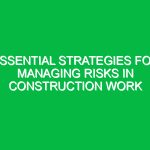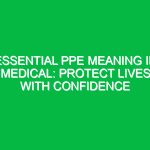Introduction
Hello team! Thank you for gathering today for this toolbox talk. As we prepare to start our work, it’s crucial to take a moment to discuss a topic that impacts all of us directly: poor housekeeping Hazards. Specifically, we will be focusing on the 3 Types of Poor Housekeeping Hazards that can lead to accidents and injuries in our workplace. By understanding these hazards, we can take proactive steps to maintain a safe and efficient working Environment.
Why Housekeeping Matters
Good housekeeping is not just about keeping our workspace tidy; it’s a fundamental aspect of health, safety, and environment (HSE) practices. Proper housekeeping minimizes risks, enhances productivity, and contributes to the overall morale of our team. When our environment is organized and clean, we can focus better on our tasks and reduce the likelihood of accidents.
Understanding the 3 Types of Poor Housekeeping Hazards
Now let’s dive into the 3 Types of Poor Housekeeping Hazards. Each type represents a different aspect of housekeeping that, if neglected, can lead to serious Safety issues.
1. Cluttered Workspaces
Cluttered workspaces can lead to a variety of hazards. When tools, equipment, and materials are not stored properly, they can become tripping hazards. Imagine trying to navigate through a workspace littered with cables, tools, or packaging materials. It’s easy to see how someone could trip and fall, leading to injuries that could have been easily avoided.
- Real-life Example: Consider a warehouse where pallets are stacked haphazardly, blocking walkways. An employee rushing to meet a deadline could easily trip over a misplaced pallet, resulting in a sprained ankle or worse.
- Best Practices: Ensure that all tools and materials are returned to their designated storage areas immediately after use. Implement a “clean as you go” policy to keep workspaces organized throughout the day.
2. Poorly Maintained Equipment
Another critical type of poor housekeeping hazard is poorly maintained equipment. This includes machinery, tools, and Safety equipment that are not regularly serviced or cleaned. Equipment that is in disrepair can fail when you least expect it, posing a risk to those using it.
- Hypothetical Scenario: Imagine a scenario where a worker uses a power tool that hasn’t been inspected for months. If the tool malfunctions, it could cause severe injuries or even fatalities.
- Action Steps: Conduct regular Maintenance checks and document any repairs or replacements. Encourage employees to report any equipment issues immediately so they can be addressed before they escalate.
3. Inadequate Waste Management
The final type of poor housekeeping hazard involves inadequate waste management. This can include everything from not disposing of hazardous materials properly to allowing general waste to accumulate. Such negligence can lead to fire hazards, chemical spills, or even pest infestations.
- Case Study: An industrial site that failed to dispose of chemical waste properly faced significant fines and cleanup costs after a spill contaminated the surrounding area.
- Best Practices: Follow all company policies on waste disposal, especially for hazardous materials. Designate specific areas for waste collection and ensure they are emptied regularly.
The Importance of Preventing Poor Housekeeping Hazards
Each of these 3 Types of Poor Housekeeping Hazards contributes to an unsafe work environment. By acknowledging the risks associated with cluttered workspaces, poorly maintained equipment, and inadequate waste management, we can actively work to mitigate them. It’s not just about compliance; it’s about creating a culture of safety and accountability.
Compliance and Regulations
Adhering to health and safety regulations is a crucial aspect of our work. Regulations from organizations such as OSHA (Occupational Safety and Health Administration) outline the responsibilities employers have to ensure a safe workplace. Non-compliance can result in serious consequences, including fines, legal actions, and increased insurance costs. More importantly, it can compromise our safety.
Actionable Advice for Employees
As we move forward, I encourage everyone to take ownership of our housekeeping practices. Here are some actionable steps you can take to help prevent the 3 Types of Poor Housekeeping Hazards:
- Regularly Assess Your Workspace: Take a few minutes at the start and end of each shift to assess your work area. Is everything in its place? Are there any hazards that need addressing?
- Engage in Team Clean-Up Days: Organize regular clean-up days with your team. This not only ensures cleanliness but also fosters teamwork and camaraderie.
- Report Issues Promptly: If you notice something that could pose a hazard, report it to your supervisor immediately. Remember, safety is a collective responsibility.
Encouraging Discussion
Before we wrap up today’s toolbox talk, I’d like to open the floor for discussion. What are some challenges you face in maintaining housekeeping Standards? Are there specific areas where you think we can improve? Your input is valuable, and together we can create a safer workplace.
Conclusion
In summary, the 3 Types of Poor Housekeeping Hazards—cluttered workspaces, poorly maintained equipment, and inadequate waste management—are critical factors that can lead to unnecessary accidents and injuries. By understanding and addressing these hazards, we not only comply with safety regulations but also protect ourselves and our coworkers. Thank you for your attention, and for your commitment to maintaining a safe work environment. Let’s work together to keep our workplace safe and efficient!


